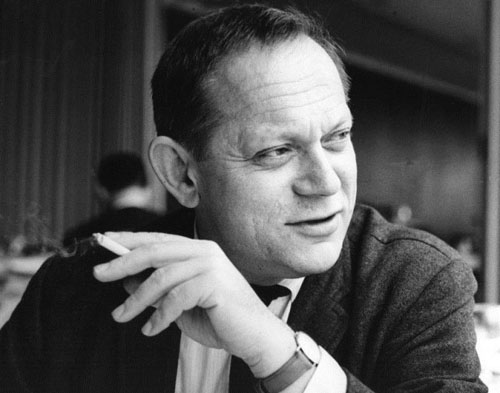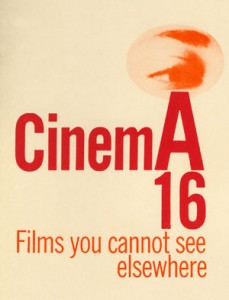Amos Vogel: Indie Pioneer
Written by: FFT Webmaster | May 7th, 2012
 Long before indie was a name brand and events like Sundance and Tribeca creates red carpet media mania for the indie superstars, independent film was called underground cinema, and had a delicious if shadowy reputation in a domain then completely dominated by the Hollywood studios. It is worth remembering that those who committed themselves to independent cinema in those lean early years did so out of political and social conviction. They did not see independent cinema as a convenient “calling card” to eventual Hollywood success. These individualists reveled in their anti-establishment position, using the burgeoning underground cinema scene as an counter-cultural balance to what film (and by extension the greater society ) could be.
Long before indie was a name brand and events like Sundance and Tribeca creates red carpet media mania for the indie superstars, independent film was called underground cinema, and had a delicious if shadowy reputation in a domain then completely dominated by the Hollywood studios. It is worth remembering that those who committed themselves to independent cinema in those lean early years did so out of political and social conviction. They did not see independent cinema as a convenient “calling card” to eventual Hollywood success. These individualists reveled in their anti-establishment position, using the burgeoning underground cinema scene as an counter-cultural balance to what film (and by extension the greater society ) could be.
Well, one of the true keepers of the indie flame passed away last week, and it was worth noting his accomplishments and his vision. Amos Vogel, 91, passed away in his adopted city of New York on April 24. A co-founder of the original New York Film Festival, which continues to this day to showcase independent and international cinema that often does not find a comfortable place at the multiplex, Vogel was born in Vienna in 1921 as Amos Vogelbaum and fled Austria with his parents in 1938. His mother, Mathilde, was a teacher, and his father, Samuel, a lawyer. His father helped kindle young Amos’s interest in movies when he brought home a 9.5-millimeter camera. Young Amos became a Vienna film society member and years later fondly recalled seeing NIGHT MAIL, a pioneering 1936 documentary about a British mail train that preceded the realism movement in documentary film that was to take hold two decades later.
Fleeing the Nazis, his family spent several months in Cuba before coming to the United States. Amos, who was determined to make a life in a Jewish homeland, prepared for living on a kibbutz by studying animal husbandry at the University of Georgia. But by 1941 he had abandoned his belief in Zionism and had settled in New York, where he trained as a diamond cutter in the Manhattan jewelry district. Eventually he graduated from the New School for Social Research, then a hotbed of innovative thinking about everything in the arts.
 Vogel founded the avant-garde film club Cinema 16 in New York with his wife Marcia in 1947, which they jointly ran for 16 years. Cinema 16 grew out of his frustration at not being able to easily see the experimental films he was reading about. Inspired by pioneering experimental filmmaker Maya Deren, who had taken the unusual step of presenting her own films at the Provincetown Playhouse in Greenwich Village, Vogel showed his first program there, as well. It included MONKEY INTO MAN, a film by Julian Huxley about evolution, and LAMENTATION, a Martha Graham dance film. His second program included a silent documentary film called THE PRIVATE LIFE OF A CAT, produced by Deren and her husband, Alexander Hammid, which was banned as obscene because it explicitly showed the birth of kittens. A later program, heavily advertised, almost put the Vogels out of business when a snowstorm kept the audience away. They then decided to turn the club into a members-only club and sell subscriptions, giving them some financial security and allowing them to evade censorship laws that applied to commercial theaters.
Vogel founded the avant-garde film club Cinema 16 in New York with his wife Marcia in 1947, which they jointly ran for 16 years. Cinema 16 grew out of his frustration at not being able to easily see the experimental films he was reading about. Inspired by pioneering experimental filmmaker Maya Deren, who had taken the unusual step of presenting her own films at the Provincetown Playhouse in Greenwich Village, Vogel showed his first program there, as well. It included MONKEY INTO MAN, a film by Julian Huxley about evolution, and LAMENTATION, a Martha Graham dance film. His second program included a silent documentary film called THE PRIVATE LIFE OF A CAT, produced by Deren and her husband, Alexander Hammid, which was banned as obscene because it explicitly showed the birth of kittens. A later program, heavily advertised, almost put the Vogels out of business when a snowstorm kept the audience away. They then decided to turn the club into a members-only club and sell subscriptions, giving them some financial security and allowing them to evade censorship laws that applied to commercial theaters.
Cinema 16 eventually drew some 7,000 subscribers and was an “in” place for local raconteurs and artists who wanted to demonstrate what is now referred to as “indie cred”. The organization eventually was based at a 1000 seat theater that was long since been torn down in what is now the buildings of the Fashion Institute of Technology. The club, a forerunner of the current vogue for film societies, provided daring filmmakers from around the world — Roman Polanski, John Cassavetes, Luis Buñuel, Yasujiro Ozu, Robert Bresson, Alain Resnais and Stan Brakhage among them — a place for their work to be screened for American audiences at a time when there were few if any others. It also became a distribution center for experimental films where presenters could find films that had been available only from the filmmakers themselves. After financial strains forced Cinema 16 to close in 1963, Vogel, along with film critic Richard Roud, founded the New York Film Festival, which will present its 50th program this year. As its first director, he gave American audiences their initial exposure to Luis Buñuel’s EXTERMINATING ANGEL and Gillo Pontecorvo’s BATTLE OF ALGIERS, among many other iconic films. His 1974 book, Film as a Subversive Art is considered a seminal text dealing with the power of cinema to challenge commonly accepted aesthetic, political, sexual and ideological standards.
 A champion of international and independent cinema, Vogel was a film consultant to Grove Press and National Educational Television and a program director of the National Public Television Conference. He also served as chairman of the American Selection Committee for the Cannes, Moscow, Berlin and Venice film festivals. Vogel also taught at Harvard, the New School for Social Research and NYU. In 1973, Vogel started the Annenberg Cinematheque at the University of Pennsylvania and later lectured at the university’s Annenberg School for Communication for two decades. “The commercialization of art and entertainment is a negative factor in human development,” he said in a 2004 documentary by Paul Cronin. He remained an outsider to the burgeoning indie art film movement of the 1980s and 1990s, considering it a commercial distortion of what had been the purist artistic vision of an earlier generation of film artists.
A champion of international and independent cinema, Vogel was a film consultant to Grove Press and National Educational Television and a program director of the National Public Television Conference. He also served as chairman of the American Selection Committee for the Cannes, Moscow, Berlin and Venice film festivals. Vogel also taught at Harvard, the New School for Social Research and NYU. In 1973, Vogel started the Annenberg Cinematheque at the University of Pennsylvania and later lectured at the university’s Annenberg School for Communication for two decades. “The commercialization of art and entertainment is a negative factor in human development,” he said in a 2004 documentary by Paul Cronin. He remained an outsider to the burgeoning indie art film movement of the 1980s and 1990s, considering it a commercial distortion of what had been the purist artistic vision of an earlier generation of film artists.
And yet he was lionized by young film mavens and directors, including Martin Scorsese, an avid film buff and preservationist, who praised Vogel in interviews in recent days. “If you’re looking for the origins of film culture in America, look no further than Amos Vogel,” Scorsese was quoted as saying. “Between Cinema 16 (which opened our eyes to Maya Deren, Stan Brakhage, Bruce Conner, Kenneth Anger, John Cassavetes and hundreds of other visionary films and filmmakers), the New York Film Festival and his book ‘Film as a Subversive Art, Amos opened the doors to every possibility in film viewing, film exhibition, film curating, film appreciation. He was also unfailingly generous, encouraging and supportive of so many young filmmakers, including me when I was just starting to make my first pictures.” This is a man to be remembered and to be missed.


